Evaluation of Water Resource Carrying Capacity and Analysis of Driving Factors in the Dadu River Basin Based on the Entropy Weight Method and CRITIC Comprehensive Evaluation Method
Abstract
1. Introduction
2. Research Area and Data
2.1. Research Area
2.2. Data Sources
3. Research Methods
3.1. Establishment of the WRCC Evaluation Index System
3.1.1. Evaluation Index System
3.1.2. Dimensional Processing of the Index System
3.2. Development of the Combined Weight Model
3.2.1. The CRITIC Method
3.2.2. Entropy Weight Method
- (1)
- The sub-indicators are standardized using Equations (3)–(8) and Equations (3)–(9). Building upon this standardization, a new discriminant matrix is constructed .
- (2)
- The proportion of the -th evaluation object for the -th indicator is determined using the following formula:
- (3)
- If we denote the entropy value of the -th evaluation index as , its calculation can be expressed by the following formula:
- (4)
- The entropy weight corresponding to each evaluation index can be expressed using the following mathematical expression:
3.2.3. CRITIC–Entropy Weight Method Combined Weight Method
3.2.4. Classification of WRCC Evaluation Results
3.3. Obstacle Degree Model of WRCC
4. Analysis of WRCC Results and Driving Factors in the Dadu River Basin
4.1. Temporal Variation Characteristics of WRCC
4.2. Spatial Characteristics of WRCC
4.3. The Primary Driving Forces Behind the Development of WRCC
5. Discussion
5.1. Discussion on the Development Differences of WRCC Among Counties in the River Basin
5.2. Analysis of the Driving Mechanism for the Development of WRCC
5.3. Analysis of Driving Force Transformation
5.4. Policy Recommendations
6. Conclusions
- (1)
- From a temporal perspective, the WRCC in the Dadu River Basin exhibited a generally fluctuating upward trend from 2011 to 2020. While interannual variations remained relatively stable, disparities among districts and counties began to widen over time.
- (2)
- From a spatial perspective, the disparities in WRCC among districts and counties become increasingly pronounced from the upstream to the downstream regions. The downstream area (0.56) approaches level IV due to economic agglomeration and technological advancements; conversely, upstream areas (0.52) face constraints stemming from conflicts between ecological protection and resource development, resulting in a dual pattern characterized by “catching up–lagging.”
- (3)
- In terms of specific indicators, per capita water resources, ecological environmental water consumption rate, total water supply volume, per capita GDP, fertilizer application volume, and rainfall emerge as primary obstacles affecting WRCC within the Dadu River Basin. Analyzing subsystems reveals that water resources constitute the principal constraint on advancing WRCC in this region.
- (4)
- Based on the research findings, formulate actionable policy recommendations. Firstly, the upstream area explores a comprehensive regional development model, while the downstream area implements a zonal management system. At the same time, enhance the water conservation awareness of residents within the basin. Secondly, based on the differences in economic conditions and water resource endowments, strengthen remote cooperation among regions to form a complementary and coordinated development model. Thirdly, we should strengthen the protection of the ecosystem in the Dadu River Basin to achieve green, coordinated, and sustainable development.
Author Contributions
Funding
Data Availability Statement
Conflicts of Interest
Abbreviations
| WRCC | Water Resource Carrying Capacity |
References
- Vairavamoorthy, K.; Gorantiwar, S.D.; Pathirana, A. Managing urban water supplies in developing countries—Climate change and water scarcity scenarios. Phys. Chem. Earth 2008, 33, 330–339. [Google Scholar] [CrossRef]
- Dong, H.J.; Geng, Y.; Fujita, T. Uncovering regional disparity of China’s water footprint and inter-provincial virtual water flows. Sci. Total Environ. 2014, 500–501, 120–130. [Google Scholar] [CrossRef] [PubMed]
- Li, J.W.; Liu, Z.F.; He, C.Y. Water shortages raised a legitimate concern over the sustainable development of the drylands of northern China: Evidence from the water stress index. Sci. Total Environ. 2017, 590–591, 739–750. [Google Scholar] [CrossRef] [PubMed]
- Ma, T.; Sun, S.; Fu, G.T. Pollution exacerbates China’s water scarcity and its regional inequality. Nat. Commut. 2020, 11, 650. [Google Scholar] [CrossRef] [PubMed]
- Ostad-Ali-Askari, K. Developing an optimal design model of furrow irrigation based on the minimum cost and maximum irrigation efficiency. Appl. Water. Sci. 2022, 12, 144. [Google Scholar] [CrossRef]
- Ostad-Ali-Askari, K. Investigation of meteorological variables on runoff archetypal using SWAT: Basic concepts and fundamentals. Appl. Water. Sci. 2022, 12, 177. [Google Scholar] [CrossRef]
- Ostad-Ali-Askari, K. Management of risks substances and sustainable development. Appl. Water. Sci 2022, 12, 65. [Google Scholar] [CrossRef]
- Khorsandi, M.; Homayouni, S.; van Oel, P. The edge of the petri dish for a nation: Water resources carrying capacity assessment for Iran. Sci. Total Environ. 2022, 817, 153038. [Google Scholar] [CrossRef]
- Magri, A.; Berezowska-Azzag, E. New tool for assessing urban water carrying capacity (WCC) in the planning of development programs in the region of Oran, Algeria. Sustain. Cities Soc. 2019, 48, 101316. [Google Scholar] [CrossRef]
- Yang, H.Y.; Tan, Y.A.; Sun, X.B.; Cheng, X.W.; Liu, G.Q.; Zhou, G.Y. Comprehensive evaluation of water resources carrying capacity and analysis of obstacle factors in Weifang City based on hierarchical cluster analysis-VIKOR method. Environ. Sci Pollut. Res. 2021, 28, 50388–50404. [Google Scholar] [CrossRef]
- Costa Freitas, M.B.; Xavier, A.; Fragoso, R. A composite indicator to measure sustainable water use in Portugal: A compromise programming approach. J. Environ. Manag. 2022, 311, 114791. [Google Scholar] [CrossRef] [PubMed]
- Dehghani, S.; Massah Bavani, A.R.; Roozbahani, A. Towards an integrated system modeling of water scarcity with projected changes in climate and socioeconomic conditions. Sustain. Prod. Consum. 2022, 33, 543–556. [Google Scholar] [CrossRef]
- Naimi-Ait-Aoudiaa, M.; Berezowska-Azzaga, E. Algiers carrying capacity with respect to per capita domestic water use. Sustain. Cities Soc. 2014, 13, 1–11. [Google Scholar] [CrossRef]
- Peng, T.; Deng, H.W. Comprehensive evaluation on water resource carrying capacity based on DPESBR framework: A case study in Guiyang, southwest China. J. Clean. Prod. 2020, 268, 122235. [Google Scholar] [CrossRef]
- Yang, Z.Y.; Song, J.X.; Cheng, D.D. Comprehensive evaluation and scenario simulation for the water resources carrying capacity in Xi’an city, China. Environ. Manag. 2019, 230, 221–233. [Google Scholar] [CrossRef]
- Zhao, Y.; Wang, Y.Y.; Wang, Y. Comprehensive evaluation and influencing factors of urban agglomeration water resources carrying capacity. Clean. Prod. 2021, 288, 125097. [Google Scholar] [CrossRef]
- Peng, T.; Deng, H.W.; Lin, Y. Assessment on water resources carrying capacity in karst areas by using an innovative DPESBRM concept model and cloud model. Sci. Total Environ. 2021, 767, 144353. [Google Scholar] [CrossRef]
- Wang, T.Z.; Jian, S.Q.; Wang, J.Y. Dynamic interaction of water–economic–social–ecological environment complex system under the framework of water resources carrying capacity. Clean. Prod. 2022, 368, 133132. [Google Scholar] [CrossRef]
- Chen, Y.; Chen, A.T.; Zhang, D.N. Evaluation of resources and environmental carrying capacity and its spatial-temporal dynamic evolution: A case study in Shandong Province, China. Sustain. Cities Soc. 2022, 82, 103916. [Google Scholar] [CrossRef]
- Zhang, Z.; Hu, B.; Qiu, H. Comprehensive evaluation of resource and environmental carrying capacity based on SDGs perspective and Three-dimensional Balance Model. Ecol. Indic. 2022, 138, 108788. [Google Scholar] [CrossRef]
- Shen, L.Y.; Shu, T.H.; Liao, X. A new method to evaluate urban resources environment carrying capacity from the load-and-carrier perspective. Resour. Conserv. Recycl. 2020, 154, 104616. [Google Scholar] [CrossRef]
- Zhang, F.; Wang, Y.; Ma, X.J.; Wang, Y.; Yang, G.; Zhu, L. Evaluation of resources and environmental carrying capacity of 36 large cities in China based on a support-pressure coupling mechanism. Sci. Total Environ. 2019, 688, 838–854. [Google Scholar] [CrossRef] [PubMed]
- Naimi-Ait-Aoudia, M.; Berezowska-Azzag, E. Water resources carrying capacity assessment: The case of Algeria’s capital city. Habitat Int. 2016, 58, 51–58. [Google Scholar] [CrossRef]
- Fu, J.Y.; Zang, C.F.; Zhang, J.M. Economic and resource and environmental carrying capacity trade-off analysis in the Haihe River basin in China. J. Clean. Prod. 2020, 270, 122271. [Google Scholar] [CrossRef]
- Wang, X.Y.; Liu, L.; Zhang, S.L. Dynamic simulation and comprehensive evaluation of the water resources carrying capacity in Guangzhou city, China. Ecol. Indicat. 2022, 135, 108528. [Google Scholar] [CrossRef]
- Zhang, Z.; Lu, W.X.; Zhao, Y.; Song, W.B. Development tendency analysis and evaluation of the water ecological carrying capacity in the Siping area of Jilin Province in China based on system dynamics and analytic hierarchy process. Ecol. Model. 2014, 275, 9–21. [Google Scholar] [CrossRef]
- Zhang, J.T.; Dong, Z.C. Assessment of coupling coordination degree and water resources carrying capacity of Hebei Province (China) based on WRESP2D2P framework and GTWR approach. Sustain. Cities Soc. 2022, 82, 103862. [Google Scholar] [CrossRef]
- Peng, B.H.; Li, Y.; Elahi, E. Dynamic evolution of ecological carrying capacity based on the ecological footprint theory: A case study of Jiangsu province. Ecol. Indicat. 2019, 99, 19–26. [Google Scholar] [CrossRef]
- Wu, X.L.; Hu, F. Analysis of ecological carrying capacity using a fuzzy comprehensive evaluation method. Ecol. Indicat. 2020, 113, 106243. [Google Scholar] [CrossRef]
- Shen, J.; Nie, Y.; Huang, X.; Ma, M. Comprehensive assessment of water resource carrying capacity based on improved matter–element extension modeling. Water 2025, 17, 1197. [Google Scholar] [CrossRef]
- Su, Y.; Xu, X.; Dai, M. A Comprehensive Evaluation of Water Resource Carrying Capacity Based on the Optimized Projection Pursuit Regression Model: A Case Study from China. Water 2024, 16, 2650. [Google Scholar] [CrossRef]
- Lan, Y.; Zheng, W.; He, L.; Wang, D.; Wang, J.; Wu, C.; Wu, X. Study on the Spatiotemporal Evolution and Driving Factors of Water Resource Carrying Capacity in Typical Arid Regions. Water 2024, 16, 2142. [Google Scholar] [CrossRef]
- Wu, C.; Zhou, L.; Jin, J.; Ning, S.; Zhang, Z.; Bai, L. Regional water resource carrying capacity evaluation based on multi-dimensional precondition cloud and risk matrix coupling model. Sci. Total Environ. 2020, 710, 136324. [Google Scholar] [CrossRef]
- Zhang, M.; Liu, Y.M.; Wu, J.; Wang, T.T. Index system of urban resource and environment carrying capacity based on ecological civilization. Environ. Impact Assess. Rev. 2018, 68, 90–97. [Google Scholar] [CrossRef]
- Wang, Y.; Yang, G.C.; Dong, Q.L.; Cheng, L.; Shang, P.P. The scale, structure and influencing factors of total carbon emissions from households in 30 provinces of China-based on the extended STIRPAT model. Energies 2018, 11, 1125. [Google Scholar] [CrossRef]
- Cui, Y.; Feng, P.; Jin, J. Water Resources Carrying Capacity Evaluation and Diagnosis Based on Set Pair Analysis and Improved the Entropy Weight Method. Entropy 2018, 20, 359. [Google Scholar] [CrossRef]
- Su, M.; Li, C.; Xue, Y.; Wang, P.; Cheng, K.; Liu, Y. Engineering application of fuzzy evaluation based on comprehensive weight in the selection of geophysical prospecting methods. Earth Sci. Inf. 2022, 15, 105–123. [Google Scholar] [CrossRef]
- Wang, L.Y.; Huang, X.; Li, H.M. Research on the evaluation of water resources carrying capacity of nine provinces in the Yellow River Basin based on CW-FSPA. China Rural. Water Hydropower 2021, 9, 67–75. [Google Scholar]
- Zhang, L.J.; Kang, Y.; Su, X.L. Evaluation of water resources carrying capacity in the Yellow River Basin based on normal cloud model. Water Saving Irrig. 2019, 1, 76–83. [Google Scholar]
- Zhou, K. Comprehensive evaluation on water resources carrying capacity based on improved AGA-AHP method. Appl. Water Sci. 2022, 12, 103. [Google Scholar] [CrossRef]

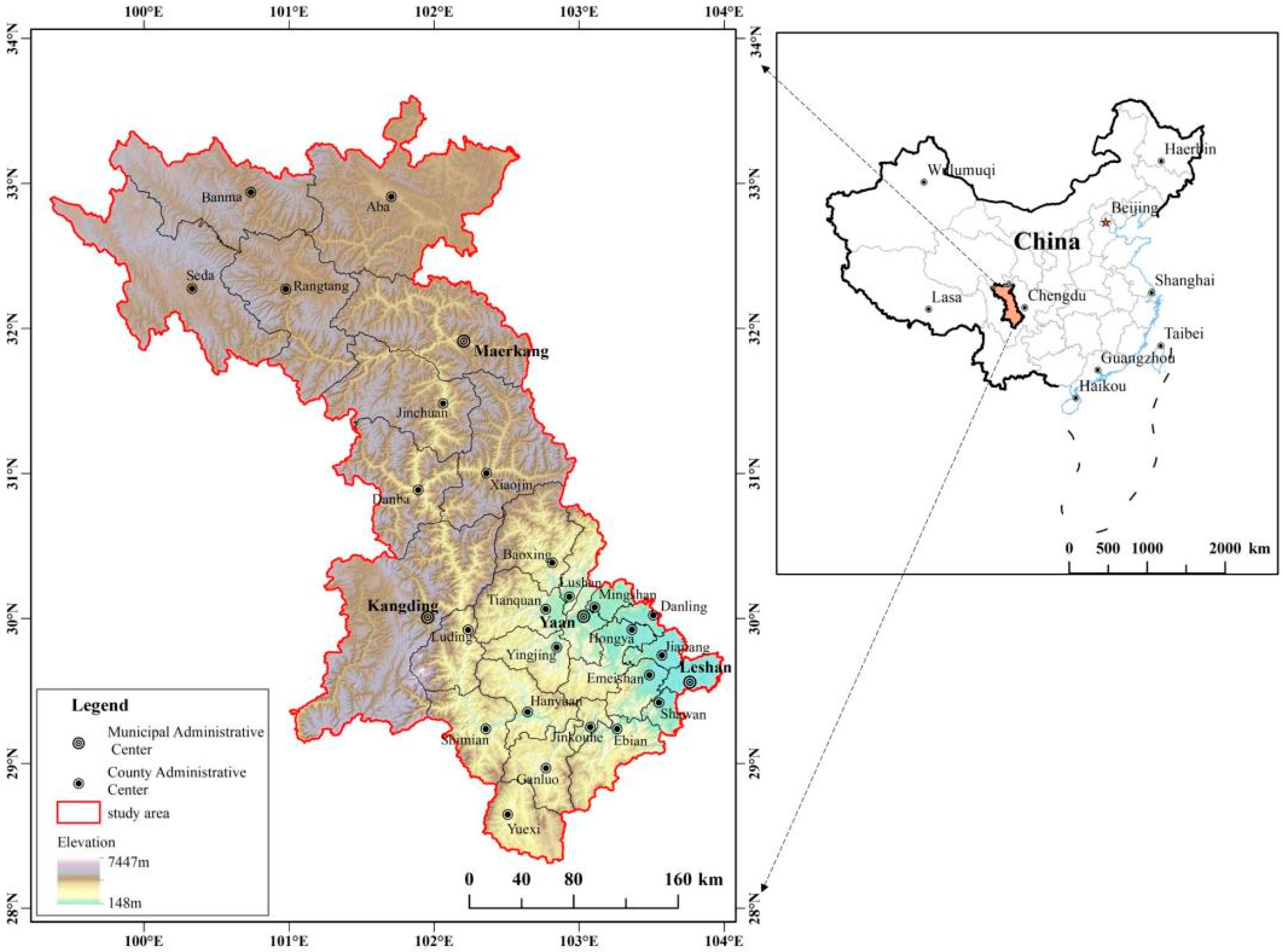
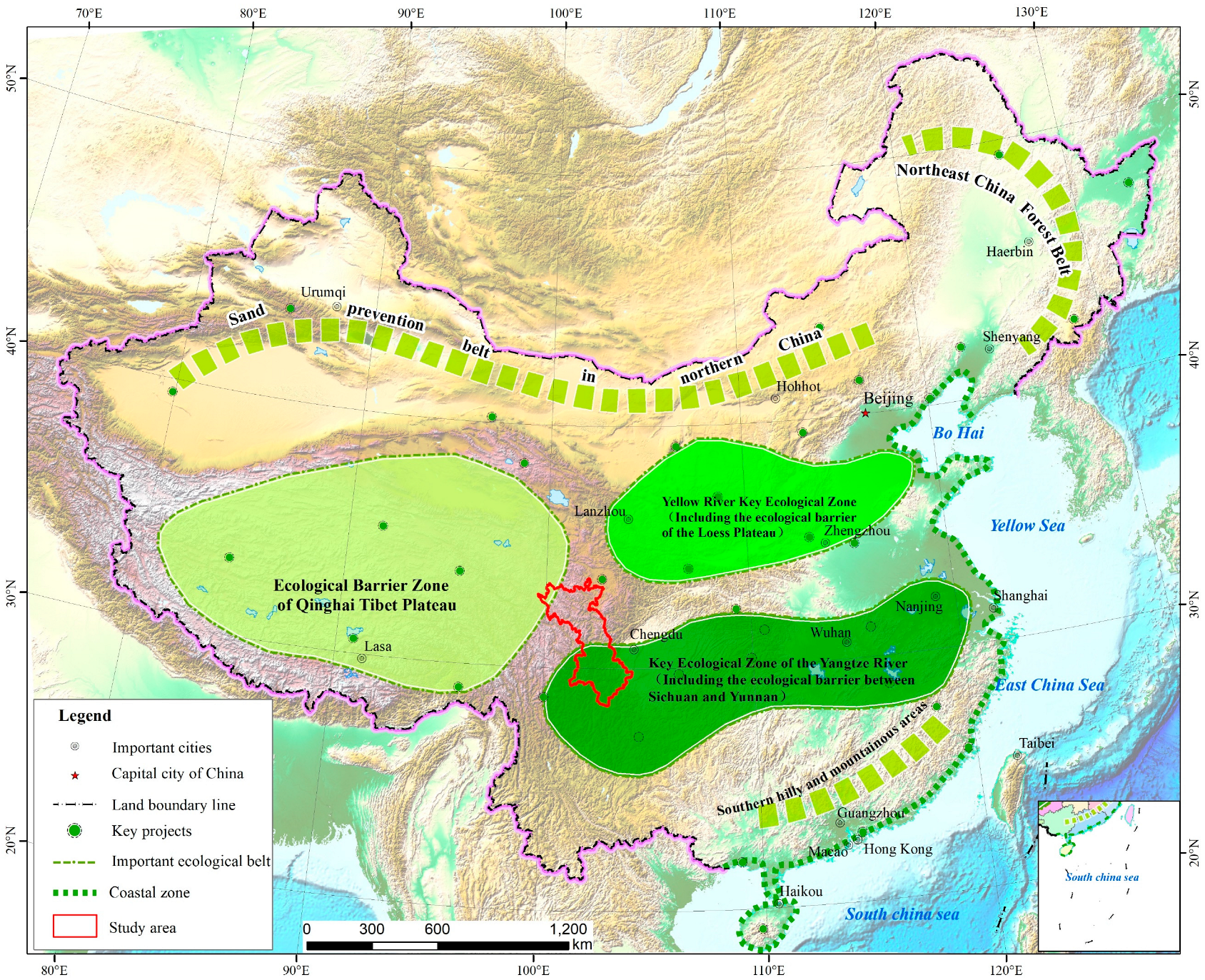

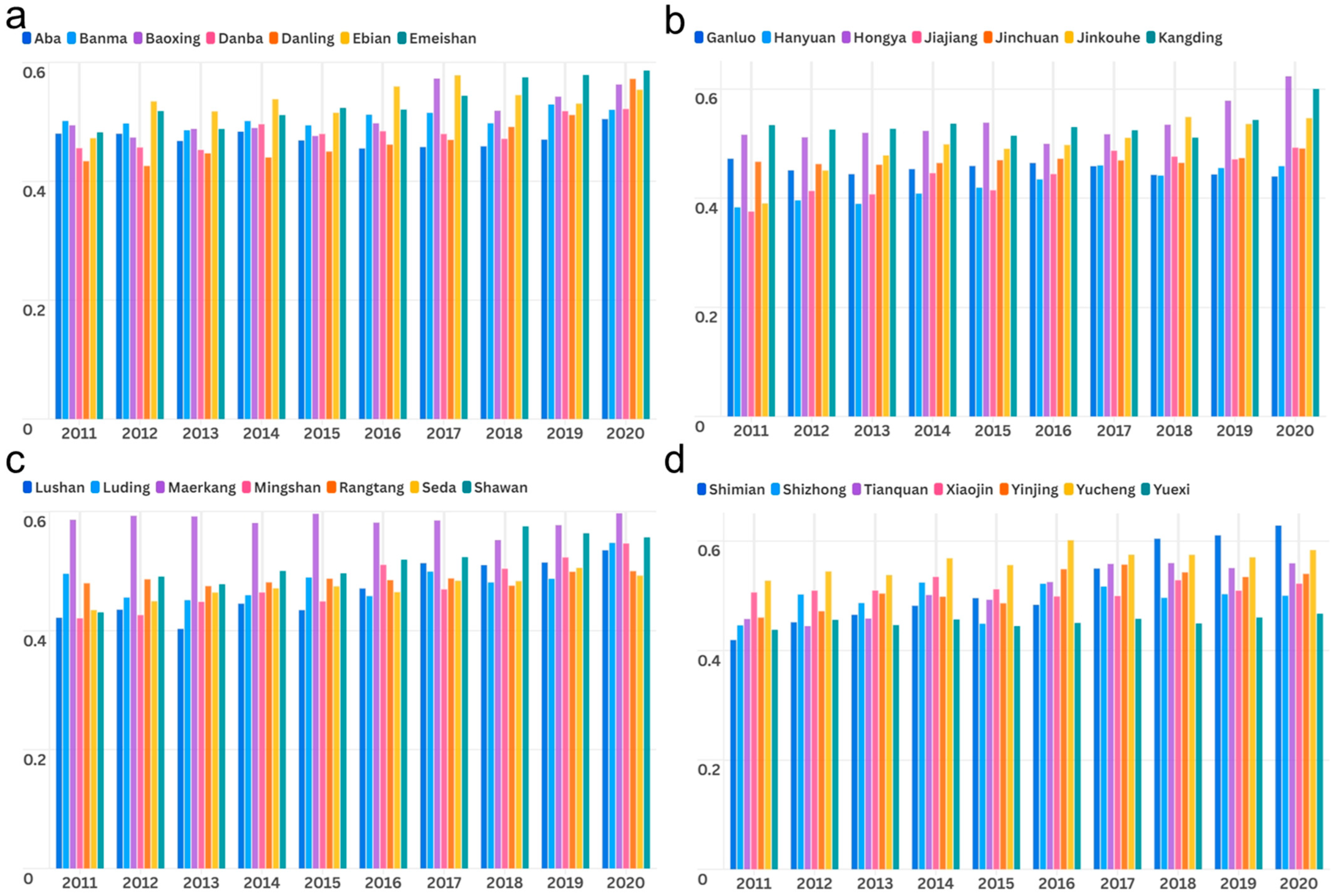
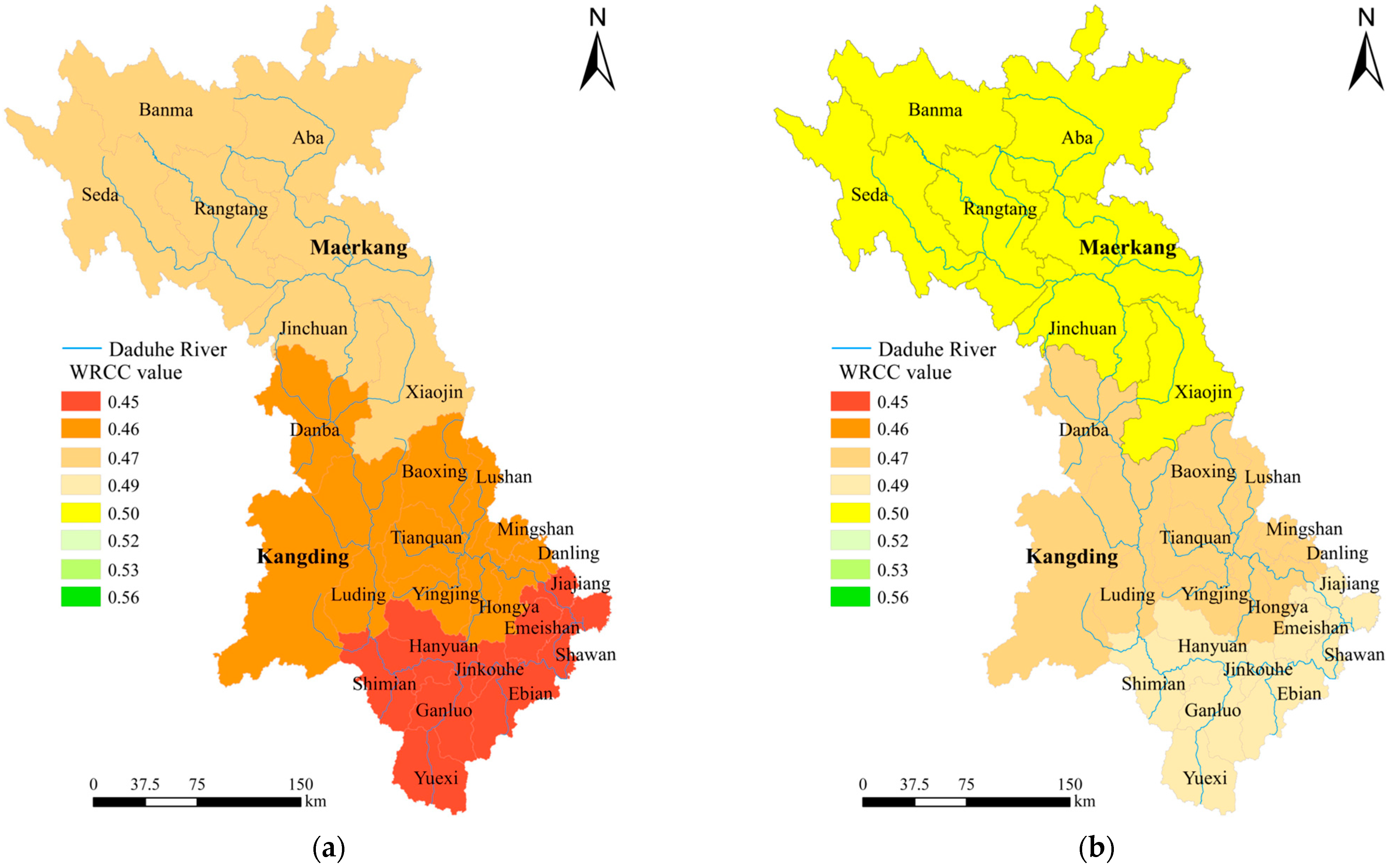
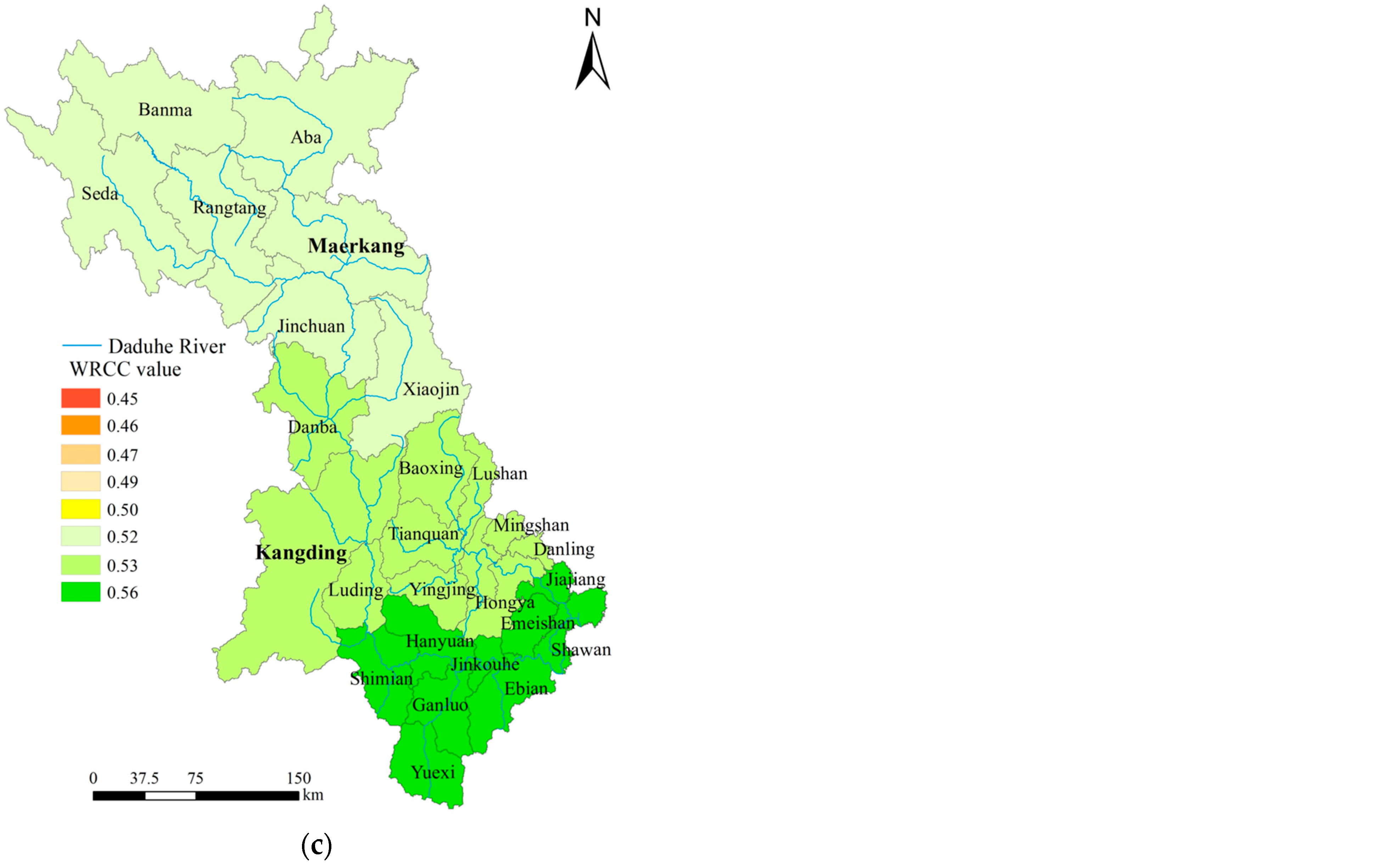
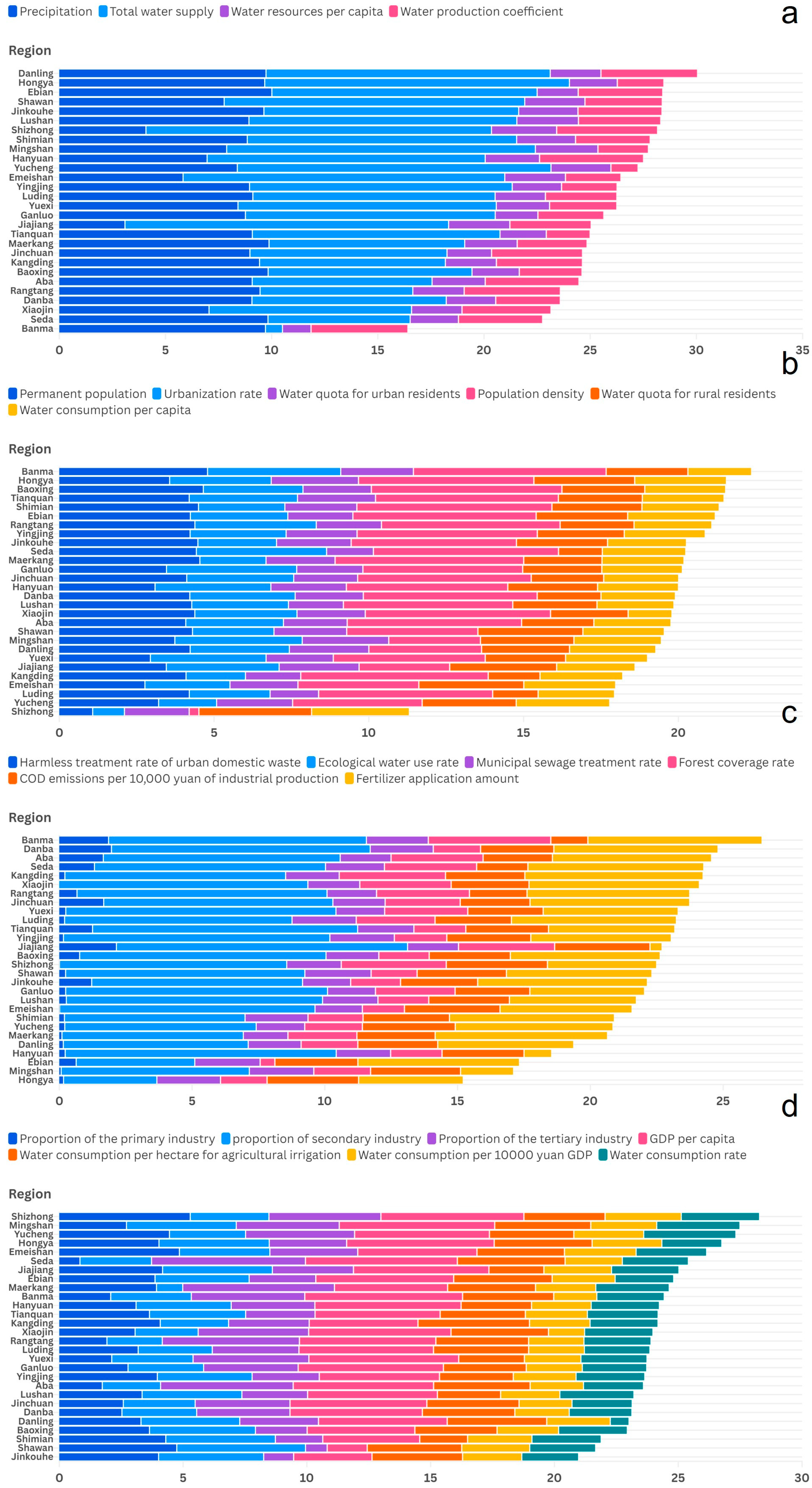
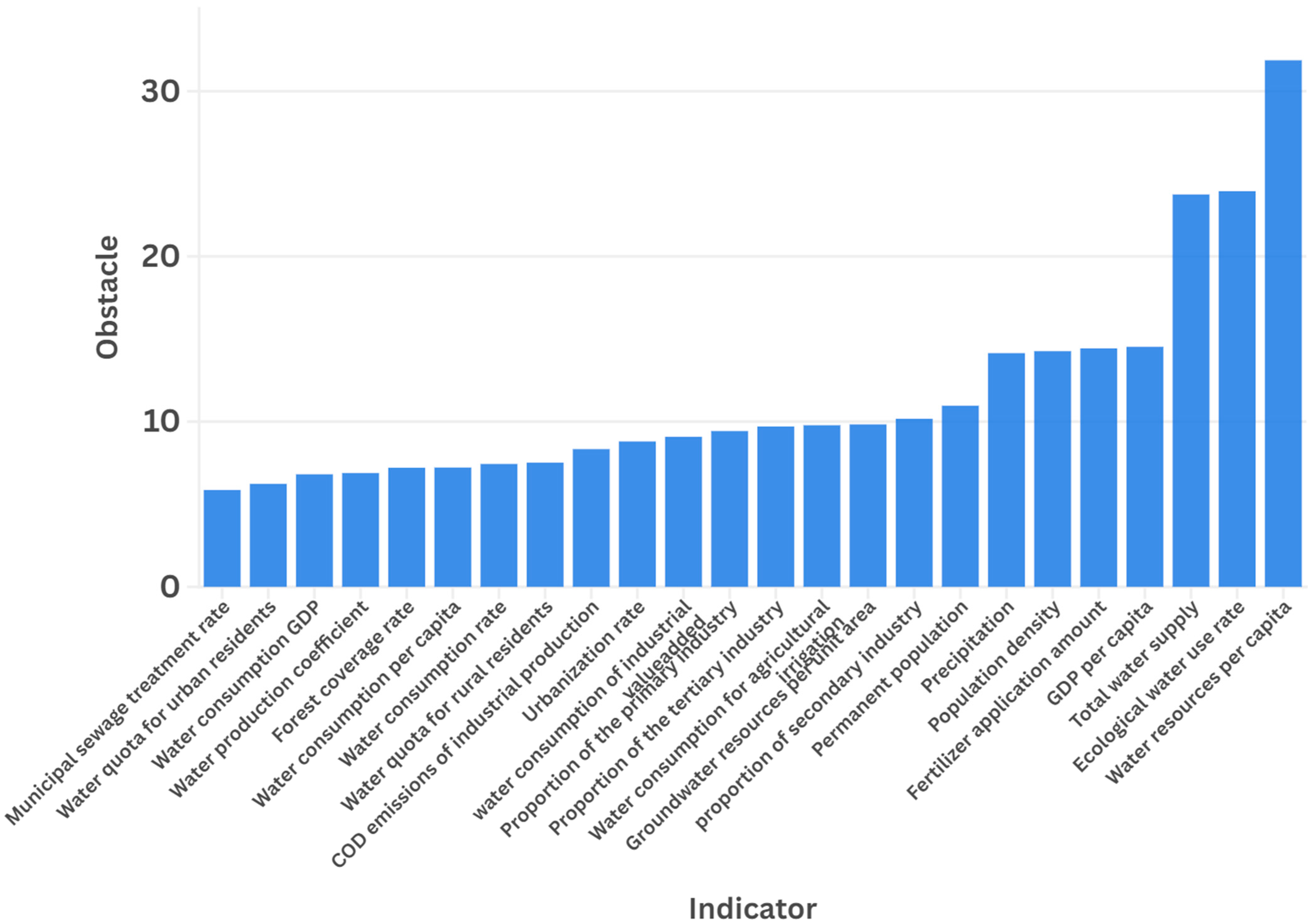
| Target Layer | Criterion Layer | Indicator Layer | Unit | Attribute |
|---|---|---|---|---|
| Water resource | Water resource endowment | Precipitation | mm | + |
| Water resources per capita | m3/person | + | ||
| Groundwater resources per unit area | 10,000 m3/km2 | + | ||
| Water production capacity | Water production coefficient | + | ||
| Total water supply | m3 | + | ||
| Social | Population composition | Population density | person/km2 | − |
| Urbanization rate | % | + | ||
| Permanent population | 104 person | − | ||
| Domestic water level | Water quota for urban residents | L/person/day | − | |
| Water quota for rural residents | L/person/day | − | ||
| Water consumption per capita | m3 | − | ||
| Economic | Scale of economic development | Proportion of the primary industry | % | − |
| Proportion of secondary industry | % | − | ||
| Proportion of the tertiary industry | % | + | ||
| GDP per capita | 10,000 CNY/person | + | ||
| Water efficiency for economic development | Water consumption per hectare for agricultural irrigation | m3/hm2 | − | |
| Water consumption per CNY 10,000 GDP | m3/104 CNY | − | ||
| Water consumption rate | % | − | ||
| Water consumption of CNY 10,000 industrial value-added | m3 | − | ||
| Ecological environment | Current situation of the ecological environment | Ecological water use rate | % | + |
| Forest coverage rate | % | + | ||
| Ecological environment management level | Municipal sewage treatment rate | % | + | |
| Harmless treatment rate of urban domestic waste | % | + | ||
| Ecological environmental pressure | Fertilizer application amount | t | − | |
| COD emissions per CNY 10,000 of industrial production | t | − |
| Criterion Layer | Indicator Layer | CRITIC Method | Entropy Weighting Method | Combined Weight |
|---|---|---|---|---|
| Water resource endowment | Permanent population | 4.43% | 1.08% | 3.43% |
| Population density | 5.55% | 1.86% | 4.44% | |
| Fertilizer application amount | 5.88% | 2.60% | 4.90% | |
| Water production capacity | Proportion of the primary industry | 3.92% | 1.43% | 3.17% |
| proportion of secondary industry | 5.50% | 3.77% | 4.98% | |
| Population composition | COD emissions per CNY 10,000 of industrial production | 2.89% | 0.52% | 2.18% |
| Water consumption per capita | 2.75% | 0.51% | 2.08% | |
| Water consumption per CNY 10,000 GDP | 2.43% | 0.38% | 1.82% | |
| Domestic water level | Water consumption per hectare for agricultural irrigation | 4.21% | 1.32% | 3.34% |
| Water consumption rate | 3.95% | 1.82% | 3.31% | |
| Water quota for urban residents | 3.09% | 0.91% | 2.44% | |
| Scale of economic development | Water quota for rural residents | 3.23% | 0.78% | 2.50% |
| water consumption of CNY 10,000 industrial value-added | 3.26% | 0.64% | 2.47% | |
| Urbanization rate | 3.74% | 3.73% | 3.74% | |
| Proportion of the tertiary industry | 4.00% | 3.82% | 3.95% | |
| Water efficiency for economic development | GDP per capita | 3.56% | 7.74% | 4.81% |
| Precipitation | 4.27% | 7.28% | 5.17% | |
| Forest coverage rate | 4.51% | 2.68% | 3.96% | |
| Municipal sewage treatment rate | 3.07% | 1.94% | 2.73% | |
| Current situation of the ecological environment | Water production coefficient | 2.78% | 1.98% | 2.54% |
| Total water supply | 4.84% | 13.55% | 7.45% | |
| Ecological environment management level | Water resources per capita | 4.97% | 19.32% | 9.28% |
| Groundwater resources per unit area | 3.96% | 4.18% | 4.03% | |
| Ecological environmental pressure | Ecological water use rate | 4.70% | 14.64% | 7.68% |
| Harmless treatment rate of urban domestic waste | 4.50% | 1.51% | 3.60% |
| Evaluation Index Range | Evaluation Grade | Water Resource Carrying Capacity Grade |
|---|---|---|
| [0–0.2) | I | Severe Overload |
| [0.2–0.4) | II | Overload |
| [0.4–0.6) | III | Critical |
| [0.6–0.8) | IV | Weakly Bearable |
| [0.8–1.0) | V | Bearable |
Disclaimer/Publisher’s Note: The statements, opinions and data contained in all publications are solely those of the individual author(s) and contributor(s) and not of MDPI and/or the editor(s). MDPI and/or the editor(s) disclaim responsibility for any injury to people or property resulting from any ideas, methods, instructions or products referred to in the content. |
© 2025 by the authors. Licensee MDPI, Basel, Switzerland. This article is an open access article distributed under the terms and conditions of the Creative Commons Attribution (CC BY) license (https://creativecommons.org/licenses/by/4.0/).
Share and Cite
Han, L.; Wang, Y.; Li, S.; Li, W.; Chen, X. Evaluation of Water Resource Carrying Capacity and Analysis of Driving Factors in the Dadu River Basin Based on the Entropy Weight Method and CRITIC Comprehensive Evaluation Method. Water 2025, 17, 2360. https://doi.org/10.3390/w17162360
Han L, Wang Y, Li S, Li W, Chen X. Evaluation of Water Resource Carrying Capacity and Analysis of Driving Factors in the Dadu River Basin Based on the Entropy Weight Method and CRITIC Comprehensive Evaluation Method. Water. 2025; 17(16):2360. https://doi.org/10.3390/w17162360
Chicago/Turabian StyleHan, Li, Yi Wang, Shaoda Li, Wei Li, and Xiaojie Chen. 2025. "Evaluation of Water Resource Carrying Capacity and Analysis of Driving Factors in the Dadu River Basin Based on the Entropy Weight Method and CRITIC Comprehensive Evaluation Method" Water 17, no. 16: 2360. https://doi.org/10.3390/w17162360
APA StyleHan, L., Wang, Y., Li, S., Li, W., & Chen, X. (2025). Evaluation of Water Resource Carrying Capacity and Analysis of Driving Factors in the Dadu River Basin Based on the Entropy Weight Method and CRITIC Comprehensive Evaluation Method. Water, 17(16), 2360. https://doi.org/10.3390/w17162360






